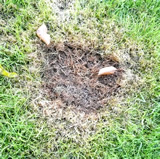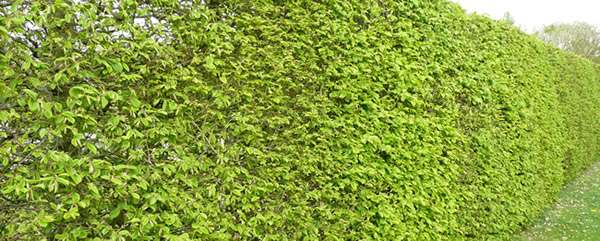

Ornamental plants
- Cut herbaceous perennials which have finished flowering down to ground level. Compost the cuttings (unless they are diseased).
- Hardy perennials such as bergenias, pinks/carnations, geraniums and violas can be divided this month.
- If you live in a cold area, dig up cannas, gladioli and dahlias when they have finished flowering, for dry storage overwinter.
- If you want to save tender perennial plants for next year, now's the time to pot them up and move them to a frost-free location.
- Check for, and eradicate, any pests on plants before you bring them indoors for the winter.
- Start planting spring bulbs in borders and containers. Hyacinths, daffodils, crocuses, fritillaries and tulips can be planted this month.
- Swap over your summer bedding for autumn colour, such as violas, pansies, polyanthus, ornamental cabbages, wallflowers and primulas.
- Now's a good time to order roses and hedging to plant over the autumn and winter.
- Small evergreen shrubs, conifers and trees (including hedging) can be planted or moved over the autumn.
- Make sure camellias and rhododendrons are well watered if there's a dry spell, this will help ensure good bud formation.
- Climbing and rambling roses can be pruned towards the end of October or next month.
- In October you can still sow/plant crops outdoors including broad beans, autumn onion sets, hardy peas and spring cabbages. Garlic can be planted this or next month.
- In the greenhouse border you can sow lettuces (which could also be grown in pots), baby spinach leaves, spring onions, early carrots and mange-tout.
- Save seeds to sow next year. Good seeds to collect include tomatoes, beans, peas, squashes, lettuces, sweetcorn, onions, beetroots and peppers.
- This month you can harvest apples, pears, marrows, sprouts, leeks, autumn cauliflowers, maincrop potatoes, carrots, parsnips, Jerusalem artichokes, pumpkins and squashes.
- Tender herbs should be protected or potted up and brought indoors this month.
- Protect tender late crops, such as salads, with cloches or horticultural fleece.
- If you're in a cold area, bring unripe greenhouse tomatoes indoors to finish ripening.
- Prune out fruited canes of blackberries, loganberries and hybrid berries.
- Hardwood cuttings can be taken from blackcurrants.
- Apply grease bands to protect apples, cherries, plums and pears from winter moths.
- Collect up, clean and store herbaceous perennial supports which are no longer needed.
- Give your greenhouse a good clean while it's still warm enough to put your plants outside when you're doing it.
- Reduce the amount of water given to container grown plants, both indoors and outside.
- Check whether your containers are frost proof and bring any which aren't indoors.
- Give your lawn some TLC; scarifying, aerating, top dressing and feeding it this month.
- Raise the cutting height on your lawn mower to gradually increase the length of the grass.
- Cover water features and ponds with netting to stop leaves blowing into them.
- Mulch your beds and borders while the ground temperature is still fairly warm.

Acer palmatum 'Atropurpureum' is a useful tree for a small to medium sized garden, reaching a little over 6m in height and spread. It's prized for its autumn display of fiery leaves and scarlet, winged fruits. It will put on the best display when planted in neutral to acidic soil and in a sunny spot. It's a low maintenance choice and can be grown in a large container so long as it is kept well watered. Find out more...


Dogs may be man's best friend, but they can cause havoc in a garden. When a dog wants to dig it generally doesn't take care to avoid your precious plants and dog faeces, while not really damaging to a garden, are a health hazard to humans. But perhaps the most noticeable damage comes from dog urine, which burns foliage. Dogs tend to see lawns, conifers and low growing shrubs as particularly good spots to relieve themselves (as shown here). Aside from training the dog and using deterrents, a bucket of water poured on the spot straight after it's been used as a toilet will dilute the urine and minimise damage. Find out more...

Hope on the Horizon garden opened
The garden which earned the 'People's Choice' award at this year's RHS Chelsea Flower Show has been re-created at the Hope for Heroes Recovery Centre in Colchester, Essex. The silver-gilt medal winning 'Hope on the Horizon' garden, which was voted the people's favourite, was designed by Matthew Keightley, who has been working over the summer to reproduce his masterpiece as part of a larger garden at the centre for injured service men and women.

NASA growing system comes down to Earth
A crop nutrient delivery system, designed by former NASA and USA Department of Agriculture scientist John Wayne Kennedy, is to be made available to raspberry growers. Promising an up to 50% increase in yield, the system, which was invented for use on the International Space Station, can be used for a wide range of crops including potatoes, strawberries, spinach and bananas.
National Botanic Garden of Wales celebrates its silver anniversary
Celebrations have been held at the National Botanic Garden of Wales to mark 25 years since the inception of gardens. Attendees included William Wilkins, who initiated the project, and other members of the founding team.

How to plant a hedge
Hedges are a useful and versatile part of garden design; providing shelter, screening parts of the garden from view, reducing noise pollution, giving food and sanctuary to wildlife and often being of great ornamental value themselves.
Autumn is the perfect time to plant a new hedge, although they can be planted at any time of year so long as you’re prepared to keep them well watered. Autumn has the advantages that the ground is still workable and your hedging plants will have plenty of time to establish before the drier conditions of summer.
When planting your hedge you firstly need to decide how dense you want it to be. A single row will provide a windbreak and screening without taking up too much space. For greater privacy and more protection from wind and/or noise a two row hedge is best. Three rows can be planted where it’s important to make the hedge really dense, for example to enclose livestock. For a single row hedge a good rule of thumb is to have 45cm between each plant. For double or triple rows the plants should be 90cm apart with 45cm between rows, with the rows being staggered.
Soil preparation is key when planting a hedge. You’re intending the plants to stay there for a long time, and you want them to grow quickly to form a dense barrier, so you need to give them the best start. Firstly, clear all weeds, debris and large stones from the site. Ideally you should then double dig the soil, incorporating lots of organic matter. However, digging organic matter into the top 40cm of soil would do if you can’t manage double digging. The soil can be prepared well in advance of planting, so it’s ready for you to use as soon as you’ve bought you plants.
Use a taut line of twine to mark out the position of you hedge and to ensure it’s straight (or use a hosepipe to create a line if you want a curved hedge). Dig a trench, or individual holes, to twice the width of the plants’ containers and deep enough that plant will be planted to the same height as it is in the container. To help the plant establish more quickly, add some mycorrhizae fungi into the bottom of the planting hole, so it will be in direct contact with the plant’s roots.
Place the plant in the hole (spreading the roots if it was purchased as a bare rooted plant) and gradually back fill with soil, firming each layer so the roots have good contact with the soil. Firm the final layer with your feet to ensure it’s stable. Water well and top dress with a slow release fertiliser, then mulch the soil around all the plants (make sure the mulch doesn’t touch the stems).
Prune the hedge annually to encourage bushier growth and renew the top dressing and mulch each spring. Keep the hedge well watered for the first couple of years until it’s well established.
Find out more about creating the perfect hedge.

A vibrant hornbeam (Carpinus betulus) hedge.

What's on this month
As autumn starts to envelop us there are still plenty of garden events to visit, particularly if you like apples!
- 4th & 5th October - 24th Annual Apple Festival, National Trust Erddig Hall, Wrexham.
- 4th & 5th October - Great Dixter Plant Fair, Great Dixter House & Garden, Rye, East Sussex.
- 5th October - Apple Day, Tatton Park, Knutsford, Cheshire.
- 5th October - Cactus and Orchid Show, The Birmingham Botanical Gardens, Edgbaston, Birmingham.
- 7th & 8th October - RHS London Harvest Festival Show, RHS Lindley Hall, London.
- 10th to 12th October - Apple Weekend, Waterperry Gardens, Nr Wheatley, Oxfordshire.
- 12th October - Fungus Day, University of Leicester Botanic Garden, Leicester.
- 15th to 19th October - Taste of Autumn, RHS Garden Wisley, Woking, Surrey.
- 18th & 19th October - Apple Weekend in the Walled Garden, National Trust Clumber Park, Worksop, Nottinghamshire.
- 19th October - Apple Day, Forty Hall Farm, Capel Manor Gardens, Enfield, Middlesex.
- 21st to 22nd October - RHS London Shades of Autumn Show, RHS Lindley Hall, London.
- 26th October - Apple Day, Cambridge University Botanic Garden, Cambridge.
